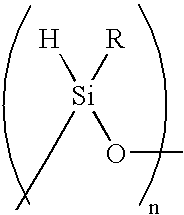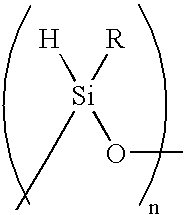Plasma coated sutures
a technology of coating sutures and filaments, applied in the field of filament coatings, can solve the problems of increasing the time to complete the closure of the suture, affecting the quality of the suture, so as to improve the handling characteristics of the coated sutur
- Summary
- Abstract
- Description
- Claims
- Application Information
AI Technical Summary
Benefits of technology
Problems solved by technology
Method used
Image
Examples
example 1
[0054]This experiment analyzed the fray resistance of synthetic sutures made of polypropylene (from United States Surgical, Norwalk, Conn.) treated in accordance with the present disclosure. Care was taken to minimize handling of the sutures, and whenever possible the sutures were handled with plastic forceps.
[0055]The siloxane derivative, 1,3,5,7-tetramethylhydrocyclosiloxane (TMCTS, HYDROSILOX®) was polymerized on the suture surface in a glow discharge plasma deposition lasting for varying amounts of time, forming a siloxane-coated suture. The TMCTS plasma was generated at 83 W, 55 mTorr, and a flow rate of 84 sccm. It was found that the application of the plasma coating for time periods ranging from 2 to 6 minutes formed polymer coatings that prevented the fraying of the polypropylene suture material.
[0056]In some cases, a second plasma polymerization process, or plasma grafting process, was utilized to introduce amine groups onto the polymer coating. N-trimethylsilylallylamine (...
example 2
[0060]This experiment compared a commercially available suture, Prolene MDE643 (Ethicon, Inc.) with a Surgipro suture (United States Surgical) possessing an HPEOC conjugated siloxane coating that was prepared in accordance with Example 1 above. The knot security, determined by whether or not the knots broke or slipped, was determined for 6 of each of the above sutures and the results are presented below in Table 2.
[0061]
TABLE 2SUTUREBREAKINGSLIPPINGProlene MDE6436 / 6 knots broke0 / 6 slippedSurgipro with HPEOC6 / 6 knots broke0 / 6 slipped
[0062]The foregoing data show that sutures coated in accordance with this disclosure have knot security equivalent to commercially available sutures, and thus exhibit an advantageous balance combination of good fray resistance and knot security.
PUM
| Property | Measurement | Unit |
|---|---|---|
| Electrical resistance | aaaaa | aaaaa |
Abstract
Description
Claims
Application Information
 Login to View More
Login to View More - R&D
- Intellectual Property
- Life Sciences
- Materials
- Tech Scout
- Unparalleled Data Quality
- Higher Quality Content
- 60% Fewer Hallucinations
Browse by: Latest US Patents, China's latest patents, Technical Efficacy Thesaurus, Application Domain, Technology Topic, Popular Technical Reports.
© 2025 PatSnap. All rights reserved.Legal|Privacy policy|Modern Slavery Act Transparency Statement|Sitemap|About US| Contact US: help@patsnap.com



